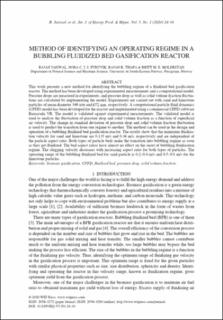| dc.contributor.author | Jaiswal, Rajan | |
| dc.contributor.author | Furuvik, Nora Cecilie Ivarsdatter | |
| dc.contributor.author | Thapa, Rajan Kumar | |
| dc.contributor.author | Moldestad, Britt Margrethe Emilie | |
| dc.date.accessioned | 2021-09-20T12:11:26Z | |
| dc.date.available | 2021-09-20T12:11:26Z | |
| dc.date.created | 2020-09-15T15:32:44Z | |
| dc.date.issued | 2020 | |
| dc.identifier.citation | Jaiswal, R., Furuvik, N. C., Thapa, R. K., & Moldestad, B. M. (2020). Method of identifying an operating regime in a bubbling fluidized bed gasification reactor. International Journal of Energy Production and Management, 5(1), 24-34. | en_US |
| dc.identifier.issn | 2056-3272 | |
| dc.identifier.uri | https://hdl.handle.net/11250/2779212 | |
| dc.description.abstract | This work presents a new method for identifying the bubbling regime of a fluidized bed gasification reactor. The method has been developed using experimental measurements and a computational model. Pressure drops are measured in experiments, and pressure drop as well as solid volume fraction fluctuations are calculated by implementing the model. experiments are carried out with sand and limestone particles of mean diameter 346 µm and 672 µm, respectively. A computational particle fluid dynamics (CPFD) model has been developed for the reactor and implemented using a commercial CPFD software Barracuda VR. The model is validated against experimental measurements. The validated model is used to analyse the fluctuation of pressure drop and solid volume fraction as a function of superficial air velocity. The change in standard deviation of pressure drop and solid volume fraction fluctuation is used to predict the transition from one regime to another. The method can be used in the design and operation of a bubbling fluidized bed gasification reactor. The results show that the minimum fluidization velocity for sand and limestone are 0.135 m/s and 0.36 m/s, respectively and are independent of the particle aspect ratio. Both types of particle beds make the transition into bubbling regime as soon as they get fluidized. The bed aspect ratios have almost no effect on the onset of bubbling fluidization regime. The slugging velocity decreases with increasing aspect ratio for both types of particles. The operating range of the bubbling fluidized bed for sand particle is 0.2–0.4 m/s and 0.5–0.8 m/s for the limestone particles. | en_US |
| dc.language.iso | eng | en_US |
| dc.title | Method of identifying an operating regime in a bubbling fluidized bed gasification reactor | en_US |
| dc.type | Journal article | en_US |
| dc.type | Peer reviewed | en_US |
| dc.description.version | publishedVersion | en_US |
| dc.rights.holder | © 2020 WIT Press. | en_US |
| dc.source.pagenumber | 24-34 | en_US |
| dc.source.volume | 5 | en_US |
| dc.source.journal | International Journal of Energy Production and Management | en_US |
| dc.source.issue | 1 | en_US |
| dc.identifier.doi | https://doi.org/10.2495/EQ-V5-N1-24-34 | |
| dc.identifier.cristin | 1830157 | |
| cristin.ispublished | true | |
| cristin.fulltext | original | |
| cristin.qualitycode | 1 | |
